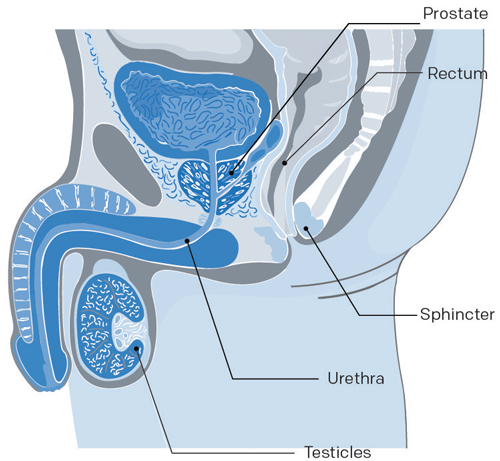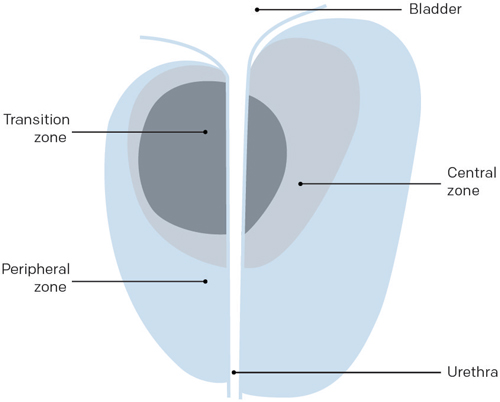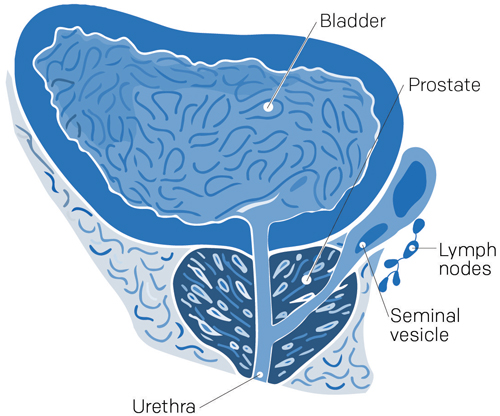Your prostate
On this page:
Discover our animated video!
Symptoms, risk and screening
Are you over 50 years old, or have you been having urinary problems for some time now? This video is for you! Several diseases can affect your prostate, and it’s important to detect them early. Let’s take a closer look.
Anatomy
What is the prostate

The prostate is a gland:
- Located between the bladder and the penis, just in front of the rectum;
- Formed of 2 lobes which surround the urethra, a canal that runs through the center of the prostate, from the bladder to the penis, letting urine and sperm flow out of the body;
- The size of a walnut, which grows larger in size in your forties;
- That has a soft, spongy texture to the touch like a small, ripe plum.
The prostate is made of:
- Gland cells that secrete liquids for ejaculation;
- Muscle cells that participate in the evacuation of your sperm during ejaculation;
- Fiber cells that maintain the structure of the gland.
Around the prostate, we find:
- The seminal vesicles, glands that produce sperm and that are located on either side of the prostate;
- The vas deferens, the tube that carries sperm from the testicle to the seminal vesicles;
- The nerve bundles that control your bladder and erectile function and that are located on either side of your prostate.
Structure
Three main zones of the prostate

Peripheral zone
- The peripheral zone is the largest area of the prostate. It can easily be felt by the doctor during a digital rectal exam (DRE).
- Most prostate cancers start in the peripheral zone.
Transition zone
- This is the area located in the middle of the prostate, between the peripheral and central areas. It surrounds your urethra that runs through the prostate.
- With age, the transitional area increases in size until it becomes the largest portion of your prostate. This is called benign prostatic hyperplasia (BPH) or enlarged prostate.
Central zone
- It is the part of the prostate that is farthest from the rectum. This is why prostate tumors located in this area can not be felt by the doctor during a digital rectal examination.
- If the doctor is in doubt, the following information will help decide if additional investigation is necessary:
- Your PSA level
- Your age and family history
- Your ethnic origin
Fonction
In short

Your fertility and natural fertilization
- It produces … a prostatic fluid rich in enzymes, proteins and minerals that nourishes and protects your spermatozoa.
- It makes … a protein (APS) that is used to liquefy your sperm to facilitate the mobility of your spermatozoa.
- It allows … ejaculation by contracting.
- It promotes … fertility through its enzymes facilitating the penetration of sperm through the cervix.
- It is not related to the mechanism of erection. Therefore, the origin of erectile dysfunction lies elsewhere.
Additional details
Exocrine Function
The prostate is made up of thousands of tiny fluid-producing glands. Specifically, the prostate is an exocrine gland. Exocrine glands are so-called because they secrete through ducts to the outside of the body (or into a cavity that communicates with the outside). Sweat glands are another example of an exocrine gland.
The fluid that the prostate gland produces forms part of semen, the fluid that carries sperm during orgasm. This fluid, produced in the prostate, is stored with sperm in the seminal vesicles. When the male climaxes, muscular contractions cause the prostate to secrete this fluid into the urethra, where it is expelled from the body through the penis.
Urine Flow
The prostate wraps itself around the urethra as it passes from the bladder to the penis. Prostatic changes can affect urine flow. Increasing the size of the prostate or muscle tone may impede the flow of urine due to the close anatomical relationship between the urethra and the prostate.
Prostate Specific Antigen (PSA)
The prostate also produces a protein called prostate-specific antigen (PSA). PSA is released with the ejaculatory fluid and can also be traced in the bloodstream. The testing of PSA levels in the blood is used to detect prostate cancer. The level of PSA in the blood is usually measured in nanograms of PSA per milliliter of blood (ng/mL).
A raised PSA level
Usually, a PSA rate of less than 4 nanograms per milliliter of blood is normal, but age should also be taken into consideration as PSA levels gradually increase with age. A rise in PSA concentration may indicate the presence of:
- An enlarged prostate (benign prostatic hyperplasia)
- An inflammation or infection of the prostate (prostatitis)
- A prostate cancer
Your doctor will have you undergo other tests to determine the exact cause of the increase in your PSA.
We are here for you
You have questions or concerns? Don’t hesitate. Contact us at 1-855-899-2873 to discuss with one of our nurses specialized in uro-oncology. They are there to listen, support and answer your questions, and those of your family or your loved ones. It’s simple and free, like all of our other services.
Also take the time to visit each of our pages on this website, as well as our YouTube channel, in order to get familiar with the disease, our expert lectures, our section on available resources, the support that is offered to you, our events and ways to get involved to advance the cause..
Staying Informed
Pages that might interest you
Want to know more? Just click on one of the links below.
The latest PROCURE news that might interest you
Every week we publish a blog article. Here are some for you.
The medical content and editorial team at PROCURE
Our team is composed of urologists, and nurses certified in uro-oncology with a deep knowledge of prostate cancer and other diseases related to the genitourinary system. Meet our staff by clicking here.
Sources and references
- Prostate Cancer – Understand the disease and its treatments; Fred Saad, MD, FRCSC and Michael McCormack, MD, FRCSC, 4th et 5th editions
- Canadian Cancer Society
- Prostate Cancer Foundation-PCF.org
- National Cancer Institute-USA
- American Cancer Society
- Memorial Sloan Kettering Cancer Center
- Prostate Cancer UK
Last medical and editorial review: September 2023
Written by PROCURE. © All rights reserved




